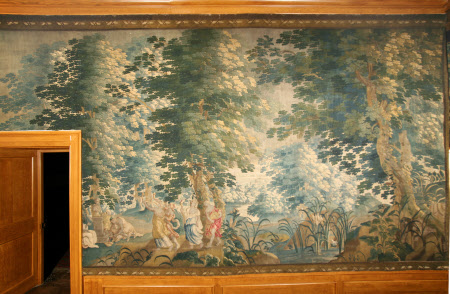Verdure with Bacchic Figures
Flemish
Category
Tapestries
Date
circa 1680 - circa 1710
Materials
Tapestry, wool and silk, 7 warps per cm
Measurements
1080 x 2790 mm
Place of origin
Belgium
Order this imageCollection
Lyme, Cheshire
NT 500371.1
Summary
Tapestry, wool and silk, 7 warps per cm, Verdure with Bacchic figures, from a set of two Verdures with Small Figures, Flemish, probably Antwerp or Oudenaarde, c. 1680-1710. A forest scene with a section cut out at the lower left hand corner. In the foreground is a group of figures making a sacrifice to a bust of Diana at a small altar. A young man wearing a laurel wreath pins a lamb to the ground with his knee and cuts its throat, the blood spurting out into a bowl on the ground. To the right a procession approaches the altar led by two women dressed in yellow robes and blowing high curved trumpets, followed by a woman wearing blue robes and carrying a torch and another wearing red robes and carrying a large golden urn. The scene is a landscape with a pool to the right where reeds and white lilies grow. The narrow borders are composed of a central band decorated with crossed ribbons and woven in imitation of a carved wooden frame. The section missing from the lower left hand side of the tapestry is displayed elsewhere in the Tapestry Dressing Room, inv. 500371.2.
Full description
The sacrifice, the altar and the seated figure to the left of it, the women with trumpets and the woman carrying an urn are all taken from a print by Pierre Brebiette (c. 1598-1642) of a procession to an altar and a sacrifice. The figures have been reversed and rearranged, with the bust of Diana on the altar added. The source for the woman carrying a torch is unknown. Although little known today Pierre Brebiette was one of the most inventive and original of the seventeenth-century French painter-printmakers and was highly regarded by contemporary connoisseurs and collectors (Orléans 2002, pp. 8-9). The print used in this tapestry is part of a series of frieze-like compositions made while Brebiette was in Rome in 1617-1624, known as the ‘Douze Grandes Frises’ (‘twelve large friezes’). The friezes are populated by a mixture of satyrs, vestal virgins, putti, goats and other animals engaged in revelry, dancing, feasting, religious rites and sacrifices, often overseen by a high priest or by a God such as Bacchus or Pan. All the images are permeated by a wild and dream-like atmosphere. The tapestry at Lyme park is clearly related to a group of Verdures at Cotehele House which have the same crossed-ribbon borders, and are also populated by figures taken from Brebiette’s ‘Douze Grandes Frises’. The designer of the Lyme and Cotehele ‘Verdures’ has inserted Brebiette’s figures into the wooded landscape backgrounds that were the stock-in-trade of many late seventeenth-century Flemish tapestry producers. Brebiette’s figures are combined with others whose sources have not been identified, but which probably also derive from prints. There is no discernable narrative to the tapestry series but the scenes are united by a general pastoral theme, drawing on but toning down the unruly bacchanalian revelry of Brebiette’s prints. None of the tapestries at Lyme or Cotehele is signed, and it is difficult to assign them to a particular weaving centre. Tapestries described as ‘verdures with small figures’ appear frequently in the records of tapestry producers and dealers in many different weaving centres in the late seventeenth century. Such tapestries occur frequently, for example, in the records of the Antwerp firm the Wauters family who supplied so many of the tapestries at Cotehele; but many other Antwerp firms also produced them, as did weavers in Oudenaarde and other centres working for Antwerp dealers. Such tapestries were often cheaper than sets with large figures as they required less skill to weave, were made with a higher wool content, and were often, but not always, more coarsely woven than historical subjects. Nonetheless these tapestries should not be disregarded as unimportant. The Verdure was the descendant of the medieval ‘millefleurs’, and was extremely popular from the early period right through the seventeenth and eighteenth centuries. Surviving inventories reveal that in the sixteenth and seventeenth centuries ‘verdure’ tapestries formed the bulk of many tapestry collections. (Helen Wyld, 2010)
Provenance
At Lyme Park since at least 1929; placed on loan from the 3rd Lord Newton to the National Trust in 1958; given to the National Trust by the 5th Lord Newton and the Hon. David Legh in 1997.
Credit line
Lyme Park, the Newton Collection (The National Trust)
Makers and roles
Flemish, workshop possibly Antwerp , workshop possibly Oudenaarde, workshop after Pierre Brébiette (c.1598 - 1650) , artist
References
Orléans, 2002: Seule la Peinture… Pierre Brebiette, exh. cat. Musée des Beaux-Arts d’Orléans 2002 Delmarcel, 1999: Guy Delmarcel, Flemish Tapestry, Tielt 1999
